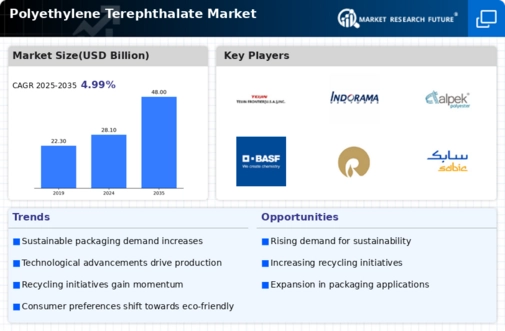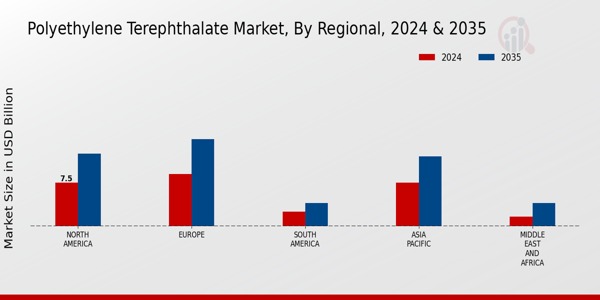Market Analysis
Polyethylene Terephthalate (Global, 2024)
Introduction
Polythene (PET) is undergoing a major change as it plays a key role in various industries, particularly in packaging, textiles and household items. PET is a versatile thermoplastic polymer, renowned for its strength, lightness and recyclability, making it the preferred choice for manufacturers and consumers. The growing demand for products made from recycled materials is also driving innovation in the PET industry. Meanwhile, the development of new technology and manufacturing methods has enhanced the properties of PET, which is being used in more specialized fields, such as the automobile and electronics industries. Against this backdrop of changing market dynamics, driven by changes in the regulatory environment and consumers’ tastes, industry players are keeping a close eye on emerging trends that could shape the future of the PET industry.
PESTLE Analysis
- Political
- In 2024, the world political scene is becoming increasingly concerned with the issue of environmentalism, which has a major impact on the polyethylene terephthalate (PET) market. In particular, the European Union is aiming to reduce the use of disposable plastic by half by 2025. The directive to recycle at least ninety per cent of PET bottles by 2029 will have an impact on production and on the market for recycled PET. The United States has allocated $1.5 billion to fund various projects aimed at increasing the amount of PET bottles being recycled. All this is having a further influence on the political climate for PET manufacturers.
- Economic
- The economic factors affecting the PET market in 2024 are the fluctuating price of raw materials and the general economic recovery post-pandemic. In 2024, the average price of crude oil, a key raw material for PET production, is estimated at $ 75 per barrel. Moreover, demand for PET will increase, and the beverage industry alone will consume about 30 million tons of PET per year. The demand for bottled beverages will grow by about 3% per year. The demand for PET will therefore be in a good position.
- Social
- Social trends in 2024 show an increase in the awareness of consumers about the environment, especially about plastic waste. Surveys show that 70% of consumers are willing to pay a higher price for products made from recycled materials, which is why brands are increasingly adopting sustainable packaging. Also, the emergence of an eco-conscious generation is changing the buying habits of consumers, with 60% of millennials favoring brands that demonstrate a commitment to the environment. This social shift is driving innovation in the PET industry as companies seek to align their products with consumers’ values.
- Technological
- In 2024, the PET market is to be influenced by technological development, especially in the field of recovery. Enzymatic processes are gaining ground, and companies are investing more than $200 million in research and development to increase the efficiency of this process. By 2025, these developments could raise the rate of PET recovery from 30% to 70%, with a considerable impact on the supply chain. And the introduction of new manufacturing techniques such as 3D printing with recycled PET is expected to open up new markets and applications for PET products.
- Legal
- In 2024 the regulations concerning the PET market are becoming more and more strict. In some countries, the EPR is applied, whereby the producers are obliged to take responsibility for the whole life cycle of their products, including post-consumer waste. In France, for example, the EPR law requires that all plastic packaging be re-usable or recyclable by 2025. Fines of up to a million francs are imposed for non-compliance, which is why companies are investing in sustainable practices and materials to meet the legal requirements.
- Environmental
- In 2024 the PET market is led by the need to reduce carbon emissions. Production of PET involves significant emissions of greenhouse gases, estimated at 3.5 kg of CO2 per kg of PET produced. Many companies have therefore vowed to be carbon neutral by 2030, investing in renewable energy and sustainable practices. The circular economy, meanwhile, is a major driver of the growth of PET. The current rate of PET recovery is about thirty per cent, but the goal is to increase this to fifty per cent by 2025.
Porter's Five Forces
- Threat of New Entrants
- Polythene terephthalate is a market with moderate entry barriers because of the considerable investment needed for plant and machinery. In addition, established players have economies of scale and brand loyalty which deter new entrants. However, technological advances and the growing demand for sustainable products could see new companies entering the market.
- Bargaining Power of Suppliers
- The bargaining power of suppliers in the PET market is relatively low because of the availability of multiple sources of raw materials, such as paraxylene and ethylene glycol. The availability of these materials allows manufacturers to easily change suppliers. Moreover, the presence of large suppliers reduces the impact of individual suppliers on the stability of supply and price.
- Bargaining Power of Buyers
- Those who buy PET, such as the makers of bottles, containers and textiles, have great bargaining power, thanks to the availability of alternative materials and the competition in the market. The larger buyers can get the best terms, but the smaller ones may find it difficult. However, the increasing emphasis on sustainability increases the buyers’ influence.
- Threat of Substitutes
- There is a moderate threat of substitution for PET because there are materials such as glass, aluminium and other plastics which can perform similar functions. However, the unique properties of PET, such as its lightness, strength and recyclability, mean that it is the preferred material in many applications. There is a growing trend towards sustainable packaging which may also lead to the development of new substitutes and may have an effect on the market dynamics.
- Competitive Rivalry
- Competition is high in the PET market, with many companies competing for a share of the market. The companies compete on price, quality and innovation, resulting in a high degree of marketing activity and frequent product launches. The PET market is characterised by high growth potential, with demand from a number of different application areas rising. This leads to intense competition between the companies as they try to differentiate themselves and win the attention of consumers.
SWOT Analysis
Strengths
- High demand in packaging applications due to its lightweight and durability.
- Recyclability of PET supports sustainability initiatives and reduces environmental impact.
- Established supply chain and production processes enhance market stability.
Weaknesses
- Dependence on petroleum-based raw materials can lead to price volatility.
- Limited biodegradability raises environmental concerns among consumers.
- Competition from alternative materials may impact market share.
Opportunities
- Growing consumer preference for sustainable and eco-friendly products.
- Expansion in emerging markets presents new growth avenues.
- Technological advancements in recycling processes can enhance product appeal.
Threats
- Regulatory pressures regarding plastic usage and waste management.
- Economic fluctuations affecting raw material costs and production.
- Increasing competition from bioplastics and other sustainable materials.
Summary
The polythene market in 2024 is characterized by strong demand driven by its packaging applications, along with a growing emphasis on the environment due to its recyclability. However, the market is faced with challenges such as its dependence on petroleum as a raw material and the growing concern about plastic waste. Opportunities exist in expanding into emerging markets and taking advantage of technological developments in polythene recycling. However, regulatory pressures and competition from other materials are likely to have a significant effect on the market.










Leave a Comment